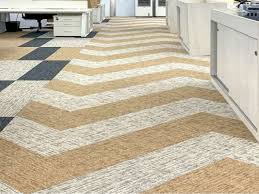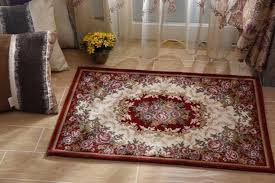WHAT’S THE DIFFERENCE BETWEEN CARPETING & WOODEN FLOORING?
Carpet comes in a great variety of colors, styles, textures and thickness. It is a good insulator and even muffles sound, which is why many homeowners and renters still prefer it in their bedrooms.
Hardwood is usually ¾ inches thick and there are many species available for different budgets and aesthetic tastes. It is also a good insulator and is very low-maintenance.
Types of Carpet
Not only is it available in a variety of colors; carpet comes with options for fiber or pile so you can zero in on the most appropriate type for your home.

Best Flooring Options for Every Room
Bathroom or Kitchen Flooring
The best flooring for bathrooms or kitchens is tile or vinyl. These materials also go well in the mudroom.
Living Room Flooring: Hardwood or Carpet
Hardwood or carpet are the best flooring choices for the living room. They offer comfort and style without compromising durability.
Dens or Family Room Flooring Ideas
When you choose flooring for the den or family room, consider vinyl or carpet. These provide an ideal balance of comfort and durability.
Durable Entryway or Foyer Flooring
Tile or vinyl are the most durable flooring options for entryways and foyers. They are waterproof and scratch-resistant.
Kinds of Flooring for Laundry Rooms
The best flooring for laundry rooms are vinyl or tile. These types can handle higher humidity and spills without warping or bleaching.
Best Floor for Stairs or Hallways
Carpet or hardwood are the most appropriate choices for stairs and hallways because they are easier to cut to unusual sizes.
Good Flooring for Bedrooms: Carpet or Cork
Good flooring for bedrooms is a soft and warm material like carpet or cork.
Offices
L
aminate and low-pile carpet make great options for home offices. They are durable, stain-resistant and ideal for high-traffic.
Basement Floors
The best basement flooring types are tile, laminate or engineered hardwood. These materials handle higher moisture better than hardwood and can be installed on a concrete subfloor.
Garage Floors
The best option for this room is concrete. Installing garage floor coatings or garage tiles helps provide a non-slip surface that is easy to clean.

Commercial flooring
The most common types of flooring used in commercial buildings are:
Vinyl
Easy to maintain, and unlike tile floors, there is no grouting involved. This means that it is good in terms of maintaining hygiene levels, making it a popular choice for hospitals, care homes, and so on. Due to vinyl’s hard wearing quality, it can withstand large amounts of foot traffic, making it suitable for a wide range of commercial environments.
Safety flooring
This is a form of flexible, heavy duty, high grade vinyl or rubber flooring with slip resistant grains included. Essential for many industries to create a safe working environment. This flooring is easy to maintain and keep clean. As the most common cause of workplace injuries are slips, trips and falls, this flooring’s slip resistant quality makes it suitable for many workplace environments.
Commercial carpets and carpet tiling
These are popular for many businesses due to the aesthetic quality that can be achieved. Carpet tiles are common in offices because instead of laying down a large role of carpet, the individual tiles can be laid down and removed as required, giving flexibility, access to raised floors and saving on wastage.

Types of Flooring
Flooring material choices are forever growing and a wide range is available to suit your needs. You can choose flooring that is hard or soft and pick from a wide a variety of styles and colors.
Flooring material can also be environmentally friendly, and choosing a material depends on where the flooring will be installed. You may prefer a softer material underfoot in the bedroom and flooring that is easier to maintain in the kitchen.
Below is list of of choices:
- Bamboo: Bamboo flooring is made from the fast growing bamboo grass and can be harvested in four or five years. Bamboo can regenerate without seeding and is often grown without pesticides. As a flooring material, bamboo is durable and dense, and wears as well as maple and oak. The natural density reduces the need to refinish as often as hardwood. Milled like hardwood, with a tongue and groove on all four sides, bamboo is easy to install.
- Carpet and Carpet Tiles: Carpeting offers warmth and softness underfoot and is often cheaper than other flooring options. Carpeting is also a good, sound absorber. Covering whole floors may be best left to the professional, but carpet tiles are also available and easy to lay. Carpet tiles can be installed in minutes, and one damaged tile can be easily replaced.
- Cork: Cork is a renewable, sustainable resource and is known for its shock-absorbing comfort underfoot, as well as its vibration and sound-dampening qualities. Cork also has insect-resistant and anti-allergenic properties. Often available in tiles, cork can be installed as a floating floor or glued down.
- Hardwood: Hardwood flooring is durable and made of solid wood all the way through. Wood choices include maple, oak, cherry, hickory, white ash, Mongolian teak, acacia, and alder.
- Engineered Wood: Similar in appearance to hardwood, engineered wood flooring is built differently. Unlike solid hardwood, engineered wood has three to seven layers laminated or glued together. More resistant to moisture, engineered flooring can be used in every room.
- Laminate flooring: Laminate flooring is created by fusing several layers of material together. The core is made of either high-density or medium-density fiberboard. Laminate flooring is hypoallergenic; stain-, scratch-, and fade-resistant. Laminate copies the look of hardwood and more recently has been made to resemble stone and ceramic tile.
- Hard Flooring: Concrete is a hard, durable flooring material with a life expectancy exceeding other flooring. Thanks to new technology, the concrete surface can be made decorative by treating it with stains and colorants, or stamping and scoring it with a pattern. Easy to clean, and if properly maintained, concrete will never have to be replaced.
Also, stone flooring is available as travertine tile, marble, granite, slate, limestone, and sandstone. Ceramic and porcelain tile is also available. - Linoleum: True linoleum is a durable flooring choice that has been around for over 100 years. Sold in sheet form or tiles, linoleum is available in a wide range of colors and patterns. The main ingredient in linoleum is linseed oil. Other materials include wood flour, pine rosin, and jute. Linoleum is also antibacterial.
- Vinyl: Vinyl is a flooring material made primarily of polyvinyl chloride. It is available in sheets or tiles, and comes in a wide range of styles and colors.
- Rubber: Rubber flooring is also available in a variety of colors, as well as textures, designs, and configurations like pavers, tiles, and snap-together panels.
How to Choose
When choosing flooring, first consider the function of each room or area. Then ask: How much traffic is this area expected to have? What is the likelihood that the floor here will be exposed to moisture? Will this room need flooring that can help dampen noise levels? Might any of the occupants of this room have allergies, chemical sensitivities, or asthma? What are likely ways this area will become dirty and how much time and money will be devoted to cleaning and maintaining this floor? Consideration of these various factors helps narrow down flooring options and ensures that the flooring in each area is well-suited to its purpose. Of course, various owners will prioritize these factors differently, but this list is a good place to start. The best floor will reduce a building’s environmental impact and toxicity level, and function well for building occupants.